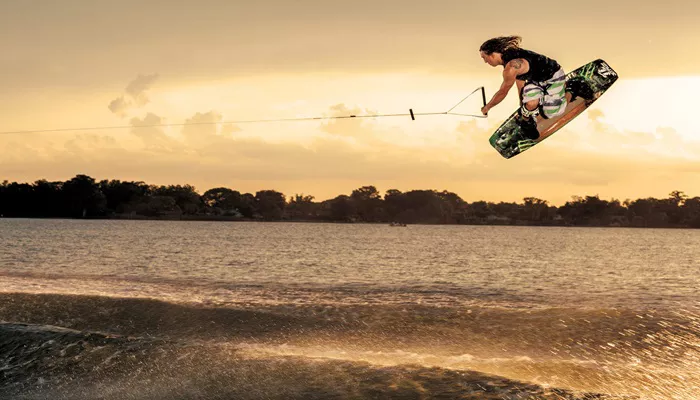Cable wakeboarding is an exhilarating water sport that combines the thrill of wakeboarding with the convenience of a cable park system. Unlike traditional boat wakeboarding, cable wakeboarding uses an overhead cable system to pull riders around a course filled with ramps, rails, and obstacles. This makes it accessible, eco-friendly, and perfect for riders of all skill levels.
Whether you’re a complete beginner or looking to refine your technique, this detailed guide will walk you through everything you need to know about cable wakeboarding.
What Is Cable Wakeboarding?
Cable wakeboarding is a variation of wakeboarding where the rider is pulled by an electrically powered cable system instead of a boat. The cable runs in a loop around a lake or a specially designed park, towing riders at speeds typically between 18 to 24 mph. The course often includes various features such as kickers, sliders, and rails, allowing riders to perform tricks and jumps.
Advantages of Cable Wakeboarding
Cost-effective: No need for a boat or fuel.
Environmentally friendly: Electric cables produce no emissions.
Consistent speed: The cable maintains a steady pace, ideal for learning.
Accessible: Cable parks are often located in urban areas.
Variety of obstacles: Great for practicing tricks and improving skills.
Essential Gear for Cable Wakeboarding
Before hitting the water, it’s crucial to have the right equipment. Here’s what you’ll need:
Wakeboard
Choose a wakeboard designed specifically for cable parks. Cable wakeboards are usually more durable and have a different rocker profile compared to boat wakeboards, optimized for hitting rails and obstacles.
Bindings
Comfortable, secure bindings are essential. They should fit snugly but not too tight, providing good ankle support while allowing some flexibility.
Helmet and Impact Vest
Safety is paramount. Always wear a helmet designed for water sports and an impact vest or buoyancy aid to protect yourself from falls and collisions.
Cable Park Pass and Tow Handle
Most cable parks require a pass or ticket. The tow handle is attached to the cable and is your connection to the system.
Step-by-Step Guide to Cable Wakeboarding
1. Understand the Cable System
Before you start, observe how the cable system works. The cable moves in a continuous loop, pulling riders around the course. The speed is usually adjustable, so beginners can start slow.
2. Getting Started: The Water Start
The water start is the fundamental skill for cable wakeboarding.
Position yourself: Sit in the water with your board perpendicular to the cable.
Grab the handle: Hold the tow handle with both hands, arms extended.
Place your feet: Position your feet in the bindings, with your dominant foot forward.
Lean back: As the cable pulls, lean back slightly to keep the board flat on the water.
Stand up: Gradually stand up by extending your legs and keeping your knees slightly bent.
3. Riding the Cable
Once you’re up, focus on maintaining balance and posture.
Keep your knees bent: This absorbs shocks and helps with stability.
Look ahead: Keep your eyes on the direction you’re going, not down at your feet.
Use your arms: Keep your arms straight but relaxed, holding the handle close to your hips.
Edge control: Use the edges of your board to steer and control your speed.
4. Navigating Obstacles
Cable parks feature various obstacles like rails and kickers. Start with simple features and progress as your confidence grows.
Approach: Maintain a steady speed and line up straight with the obstacle.
Pop: Just before the obstacle, bend your knees and then extend them to “pop” off the water or ramp.
Balance: Keep your weight centered over the board while sliding or jumping.
Land smoothly: Absorb the impact with bent knees and maintain your balance.
Tips for Beginners
Start slow: Begin at lower speeds to build confidence.
Take lessons: Professional instruction can accelerate your learning.
Practice water starts: Mastering this will make your sessions more enjoyable.
Stay relaxed: Tension makes balancing harder.
Watch others: Learn by observing experienced riders.
Common Mistakes to Avoid
Leaning too far back: This causes the board’s nose to lift and can lead to falls.
Holding the handle too high: Keep it near your hips for better control.
Stiff knees: Always keep your knees bent to absorb shocks.
Looking down: Keep your gaze forward to maintain balance.
Rushing progression: Don’t attempt advanced tricks before mastering basics.
Advanced Techniques and Tricks
Once comfortable with the basics, you can start exploring tricks such as:
Ollies: Jumping off the water without a ramp.
Grabs: Holding the board while in the air.
Slides: Riding along rails or boxes.
Spins: Rotating your body 180 or 360 degrees in the air.
Practice these in a safe environment and consider coaching to perfect your form.
Safety Considerations
Always wear a helmet and impact vest.
Check the cable park’s rules and follow them.
Warm up before riding to prevent injuries.
Be aware of other riders to avoid collisions.
Know your limits and don’t push beyond your skill level.
Conclusion
Cable wakeboarding is an exciting and accessible sport that offers endless fun and challenges. By understanding the equipment, mastering the water start, and practicing proper techniques, you can enjoy this thrilling activity safely and confidently. Whether you’re looking to cruise around the cable park or perform jaw-dropping tricks, cable wakeboarding provides a unique and rewarding experience on the water.

